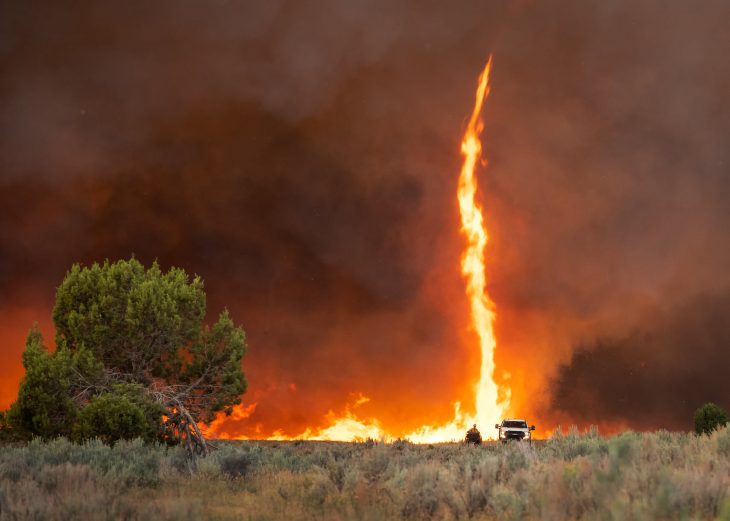
In this comprehensive article, we embark on an exploration of the captivating world of fire tornadoes, uncovering 19 fascinating facts that shed light on their formation, characteristics, and the profound impact they can have. As we delve into this infernal whirlwind of information, we will encounter the mesmerizing beauty and dangerous allure of these rare occurrences.
What is a Fire Tornado?
A fire tornado, also known as a fire whirl or firenado, is a rare weather phenomenon that occurs when a powerful vortex of flames is formed during a wildfire. It resembles a tornado in appearance, with swirling flames and intense heat.
Formation of Fire Tornadoes
Fire tornadoes typically form under specific weather conditions, including high temperatures, low humidity, and strong winds. They are often observed in large wildfires where the heat and intense updrafts create the necessary conditions for a vortex to develop.
Size and Height
Fire tornadoes can vary in size and height. They can range from a few meters to several hundred meters tall, and their diameter can span anywhere from a few meters to tens of meters.
Intensity and Heat
Fire tornadoes can generate intense heat, with temperatures reaching several hundred degrees Celsius. The combination of strong winds and extreme heat can make them extremely dangerous and destructive.
Appearance and Structure

A fire tornado appears as a spinning column of flames, similar to a traditional tornado. The flames are typically drawn upward by powerful updrafts, forming a vertical column of fire that rotates due to the swirling winds.
Factors Influencing Fire Tornadoes
Several factors contribute to the formation and behavior of fire tornadoes, including the size and intensity of the fire, wind patterns, terrain, and the availability of fuel sources. These factors can determine the size, duration, and path of a fire tornado.
Fire Tornadoes and Fire Spread
Fire tornadoes have the potential to accelerate the spread of wildfires. They can transport burning debris and embers over long distances, leading to the ignition of new fires ahead of the main fire front.
Fire Tornadoes and Firefighters
Fire tornadoes pose significant risks to firefighters battling wildfires. The unpredictable nature of these phenomena, combined with their intense heat and strong winds, makes firefighting operations challenging and dangerous.
Similarities and Differences to Atmospheric Tornadoes
While fire tornadoes share similarities with atmospheric tornadoes, such as their swirling motion, they differ in their formation and cause. Atmospheric tornadoes are formed by severe thunderstorms, while fire tornadoes are a result of the intense heat and updrafts associated with wildfires.
Fire Tornadoes and Firenadoes
The terms “fire tornado” and “firenado” are often used interchangeably to describe the same phenomenon. Both terms refer to the spinning vortex of flames seen during wildfires.
Historical Accounts of Fire Tornadoes
Fire tornadoes have been documented throughout history, with accounts dating back centuries. Historical records and eyewitness testimonies offer glimpses into the awe-inspiring power of these natural phenomena.
Fire Tornadoes in Popular Culture
The sheer spectacle of fire tornadoes has captured the attention of filmmakers, artists, and writers. They have been depicted in various forms of media, including movies, paintings, and literature, adding to their mystique and fascination.
Studying Fire Tornadoes

Scientists and researchers study fire tornadoes to better understand their formation, behavior, and potential impacts. Their findings help improve firefighting techniques, risk assessment, and public safety measures in areas prone to wildfires.
Fire Tornado Safety Precautions
If you encounter a fire tornado or are in an area at risk of its occurrence, it is crucial to follow safety guidelines provided by local authorities. This may include evacuating the area, seeking shelter in a fire-resistant structure, or moving to a safe location away from the fire’s path.
The Role of Climate Change
Climate change can influence the frequency and intensity of wildfires, which, in turn, may impact the occurrence of fire tornadoes. The connection between climate change and fire tornadoes highlights the importance of addressing and mitigating the effects of climate change.
Conclusion
As we explore the captivating world of fire tornadoes, it is essential to remember the destructive power they possess. By understanding their formation, behavior, and the factors that contribute to their occurrence, we can work towards better firefighting strategies, public safety measures, and a deeper appreciation for the forces of nature. Stay informed, stay safe, and appreciate the awe-inspiring nature of fire tornadoes.
Frequently Asked Questions (FAQs)
Are fire tornadoes more dangerous than regular tornadoes?
Fire tornadoes and atmospheric tornadoes pose different types of risks. While fire tornadoes can be extremely dangerous due to their intense heat and flame transport capabilities, atmospheric tornadoes can cause widespread damage with their strong winds and debris.
Can fire tornadoes occur without wildfires?
Fire tornadoes primarily occur in the context of wildfires. The intense heat and updrafts associated with wildfires create the conditions necessary for fire tornado formation.
Can fire tornadoes form during controlled burns?
While fire tornadoes are more commonly associated with uncontrolled wildfires, they can also occur during controlled burns if the conditions are right. Controlled burns are carefully managed fires used for land management and ecological purposes.
Can fire tornadoes be predicted?
Fire tornadoes can be challenging to predict accurately due to their complex and dynamic nature. However, advancements in fire behavior modeling and meteorological data analysis are helping scientists improve their understanding of fire tornado formation and behavior.
Can fire tornadoes extinguish themselves?
Fire tornadoes can dissipate on their own when the conditions that support their formation change. Factors such as a decrease in wind speed, an increase in humidity, or a reduction in fuel availability can contribute to the natural dissipation of a fire tornado.
Was this page helpful?
Our commitment to delivering trustworthy and engaging content is at the heart of what we do. Each fact on our site is contributed by real users like you, bringing a wealth of diverse insights and information. To ensure the highest standards of accuracy and reliability, our dedicated editors meticulously review each submission. This process guarantees that the facts we share are not only fascinating but also credible. Trust in our commitment to quality and authenticity as you explore and learn with us.


